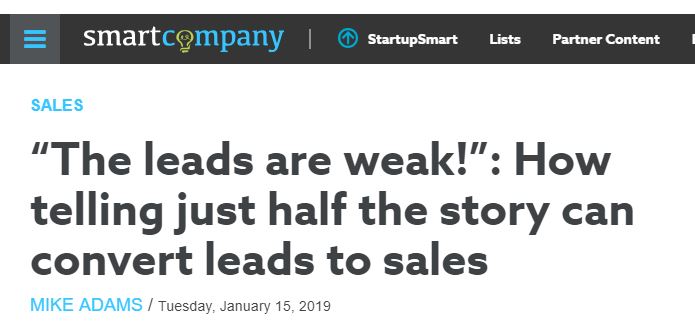Mike’s Article in Smart Company
““The leads are weak!”
“The <expletive deleted> leads are weak??? You’re weak!”
This exchange between ‘salesman’ Jack Lemmon and his boss Alec Baldwin in the classic movie Glengarry Glen Ross (1992) is repeated every time salespeople are presented with a lead list from a misguided marketing campaign. Are the leads weak or is the salesperson weak? Maybe both.
Here is how to use stories to both improve the leads and help the salesperson close them. There are only two types of lead and you must have a story lure attached to each. Prepare the stories before you start the marketing.
Insight lead
Your marketing campaign highlights an insight that your company has about your client’s market or business — something they do not know or appreciate but would profit from if they knew.
The problem with insight is, by definition, it’s not obvious. If it was obvious, it’s not insightful. But a direct challenge with the insight ‘facts’ is unlikely to be accepted because your clients are pretty sure they know how to run their business. So how does one present a non-obvious challenging idea to a client that knows what they’re doing?
The answer is in the insight story. That’s the story of how your company learnt the insight. It’s also called the researcher’s story. We tell the researcher’s discovery journey, describing the research setting, the false leads and trials, then the Eureka moment of discovery and finally explain what the discovery means. With this story, your client will co-experience the insight, understand it and accept it.
Success lead
Nothing attracts buyers like stories of people like them, that succeeded. The success lead is created from a success story — that’s a story of someone like your buyer, that succeeded with your products and services. To use a success story, it’s critical your marketing campaign targets buyers that can identify with your success story.
But a success story is not a case study. The classic three-part case study starts with your client in a terrible situation, your company rides in on your white horse and fixes the problem, and then you have a happy client. That case study format is terrible for generating leads because you will have made your company the hero, and future buyers do not identify with you, they identify with people like themselves.
The hero of your success story must be the client that succeeded with your help — you are just the guide! Start the story with your client, then introduce the challenge they were faced with. Then describe how they met your company and the plan you gave them. Finally, explain how your client avoided failure and achieved success. A well-told success story lets your future client experience your service before they buy.
Now that you have developed your lead stories it’s time to plan how marketing and sales can tell the story together in a coordinated way. The trick is in the way you create story curiosity.
Telling half the story
In many B2C sales situations, the objective of the marketing campaign is to get a conversation with a potential buyer. Marketing gets the conversation appointment and sales has the conversation to make the sale (or not, if it’s a poor fit).
The key to getting the appointment is curiosity, and the ‘half story’ creates intense curiosity.
‘To be continued …’ is the phrase that gets you yearning for next instalment of your favourite TV series. Netflix has created a $150 billion business from ‘Next episode starting in 5, 4, 3, 2, 1′ seconds…
By telling the setting and complication events of either an insight story or a success story, you’ll attract the right buyer and get them wanting to know more. That’s exactly what salespeople need — the right buyer-type wanting to know more.
How should the salesperson approach the lead? Again, with half the story.
‘I’m calling you because you expressed interest in <this setting> and this <complication> …’ The setting and complication will either be insight or success story events.
Notice we are not leading with the resolution of the story. That’s what most salespeople do. Think: ‘I’m calling to talk about how client X saved $200,000.’
That’s leading with the story resolution and that kills curiosity and screams ‘saleperson alert’!
Stories align marketing and sales
Neither the leads or the salesperson will be weak if they collaborate with strong stories. The new year is a prime time for selling. Is it time to align your marketing and sales departments with stories to take full advantage?
Mike is the co-founder and chief storyteller at The Story Leader and author of Seven Stories Every Salesperson Must Tell. He has managed sales teams in the UK, Russia and throughout Asia for international corporations such as Schlumberger, Siemens, Nokia and Halliburton and has sold over a billion dollars of products and services over his career.



